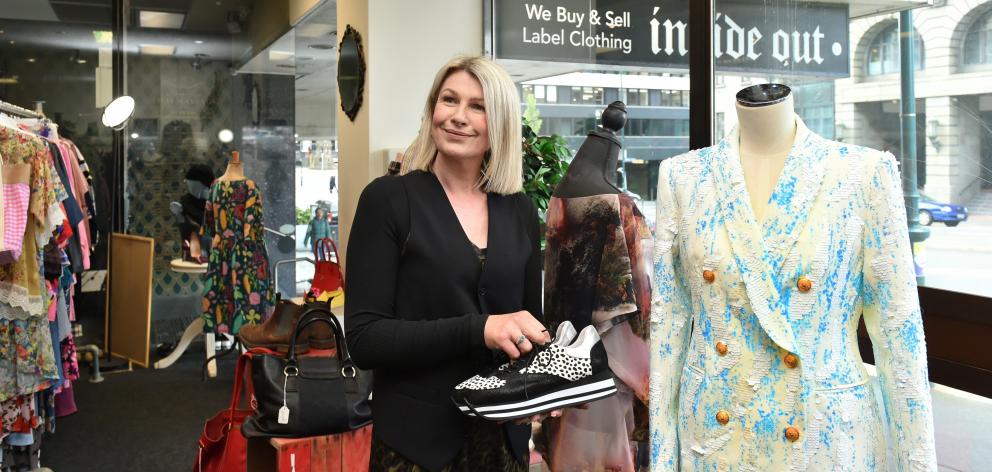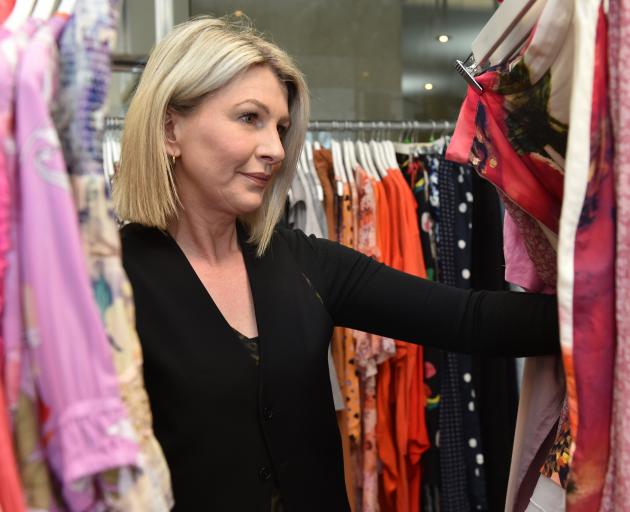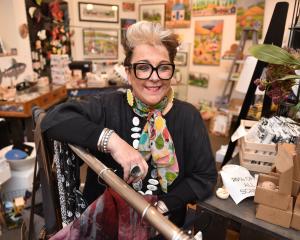
Lisa McNeill’s work examining fashion and sustainability is considered seminal on an international level and her recent study "exploring the hedonic, social or sacrificial notions of needs versus wants" is one of the top 10 most downloaded publications in the International Journal of Consumer Studies for 2020.

You were promoted to professor in February this year. Congratulations!
A professorial appointment is a humbling recognition of all the work that academics put into their university and its communities.
Teaching is only one aspect of what we do. Engaging with international debates around important issues, and trying to contribute in a meaningful, impactful way is a big part of what we spend our time on.
Being recognised for that, by the university and the international academic community, is really what a professorship is about.
Fashion is one of your key research focuses. Why is that?
Increasingly, consumers are aware of sustainability concerns in the way that we buy and consume. However, less often this is applied to our personal consumption of fashion and textiles.
I am interested in why this is the case. Fashion represents one aspect of our identity that we are strongly tied to and find it hard to change our behaviour around.
There is significant evidence that garment consumption continues to rise year upon year, even as other aspects of unsustainable consumption decrease. For example, I read recently that Costco sold approximately $9 billion in clothing alone last year, Lululemon sold $8 billion, Levi’s $6 billion.
According to the United Nations, fashion production is estimated to make up 10% of the world’s carbon emissions, is a significant polluter of all forms of water, and approximately 85% of all textiles go eventually to landfill.
The United Nations Environment Programme notes that the worldwide environmental impact of fashion is currently greater than that of all international flights and shipping combined.
What have some of your findings been?
What we found in these studies is that non-essential fashion purchasing is often strongly tied to a reasoned, rational decision-making frame, where consumers have constructed a need-based narrative that fulfils their identity motivations.
Another key finding is the lack of any consensus among consumers on what sustainable fashion actually is. Some consider fabric, some the human cost of production, others the lifecycle of garments.
Some consumers place the burden of sustainability considerations on others, some on themselves, and others ...[deem] the problem as less important than other sustainability foci.
My work has illustrated that there is a disconnect between systems designed to manage perceived overconsumption, such as fashion rental for example, and how consumers use these systems.
Charity donations are another example, where a bulk of what is donated is unusable and unsaleable. The proliferation of Shein products in charity shops in recent years underscores this issue. Donating these garments does not make the purchase of them in the first place any less concerning.
In work conducted with colleagues in Canada, South Korea and New Zealand, we found that consumers were motivated to hold on to, care for and repair or repurpose fast fashion garments, if they had fallen in love with them, and they helped them to manifest a certain identity.
Equally, consumers were fast to dispose of high-quality garments if they never emotionally connected with the garment in the first place. This is important, as it helps us to understand why people struggle to change their buying behaviour, regarding fashion. It is meaningful in a way that extends beyond the garments themselves.
You mentioned Katherine Mansfield as an example of someone well-respected intellectually who was also unashamedly passionate about fashion...
Unfortunately, fashion is a very visible target for scrutiny of what people should or shouldn’t do. There is a sense that those who enjoy fashion should feel some sense of guilt about this.
To single out one form of consumption in this way is disingenuous, particularly given how much we now know about the total sustainability impact of our different lifestyle choices.
It is interesting that fashion is seen in this way in society. There is less criticism of, for example, the book or music collector, or the traveller, than there is of the fashion collector, as though one is a hobby to be proud of, the other something to be a little shameful regarding. This often particularly impacts women and younger consumers, who enjoy fashion as their hobby.
Can you think of some current examples along similar lines?
Not really -the quote [a snippet from a letter in which Mansfield wrote some detailed thoughts on her clothing] was to illustrate the issue of how we view fashion as not a "worthwhile" pursuit. Most of the current crop of social media celebrities who post fashion are not good examples like Mansfield was!

Absolutely. Social media feeds the display element of our lives. Every choice is suddenly available for wider scrutiny and approval/disapproval.
The current proliferation of Barbie-themed fashion ... has been a great example of this. The volume of pink and pastel garments that have been highlighted in social media contexts, from fast fashion right through to ostensibly more sustainable, slow fashion, speaks to the current Barbie/Mattel zeitgeist.
To some degree, this is concerning from a sustainability perspective, as it may encourage a form of limited-use consumption that is diametrically opposed to the idea of consuming fashion in a meaningful, considered way -choosing what you love, and loving it for its lifetime, rather than choosing what brands tell you to like in the moment.
Social media is often a direct means of encouraging consumption that’s unlikely to be considered from a longevity or circular perspective. However, these products are produced, in part, because consumers desire (or demand) them.
In reality, most products can be linked to overconsumption and capitalism. However, people should also be able to express and enjoy themselves, as long as they do it in a way that they are comfortable with.
You also talked about your interest in finding ways to better equip people with the tools they need to make different choices ...
My current research seeks to highlight opportunities to increase consumer understanding of what they buy and use. Allowing the consumer to make choices that fit their personal value structure and embrace their varied identities, without the judgement of others in what is the "right" or "wrong" way to incorporate sustainability in their lives.
My research highlights several areas where the industry could serve consumers better. For example, where we agree that reducing the volume of textiles entering landfill is necessary, there is also strong evidence that some disposal of clothing is driven by a lack of repair resources, not disinterest in garment maintenance.
Professional garment repair in New Zealand is expensive, as are some of the tools required to undertake repair (such as the purchase of a sewing machine). Where community-based organisations provide access to machines and other tools, these are not widely known of by those who do not have a particular interest in sewing.
In terms of enabling consumers to make better (or at least informed) choices, the labelling of textiles is largely unregulated and confusing. Garment manufacturers can "buy" a label that indicates a non-relative aspect of sustainability, often only related to a minor part of the garment.
Further, garment retailers can effectively invent their own sustainability labelling -such as "conscious garment". Where terms are broadly understood, a retailer can label something "recycled" for example, when the reality may be that the garment is worse, in terms of overall impact, than another that is not made from recycled textile.
Essentially, there is work to be done in equipping consumers with the knowledge, skills, and access to allow them to really have more choice.
In terms of the sustainability issues in the fashion industry, have you been able to see any clear/viable solutions from your research?
I think the same way that consumers can approach any fashion choice: with care and consideration.
Choosing things that you will love and look after in the long term is one option, shopping second-hand is another.
Thinking carefully about why we love some items and why we fall out of love with, or dispose of quickly, other items, is also useful.
Are there any particular local brands you think are doing genuinely good things in the ethical/sustainability space?
My work doesn’t examine individual brands, to make this assessment. One of the problems in this area is the lack of agreement on what sustainability means, regarding garments. There are so many facets, from labour practice to end-of-use, that where a brand may be excellent on one of these measures, they may be less so on others.
It’s more useful to encourage consumers to shop consciously, to make choices that work for them, in full knowledge of what those choices mean in a sustainability context.
What is your personal take on fashion?
Buy what you really love and enjoy it and use it for as long as you can! If there’s an option to re-use, or buy second-hand, consider that. It won’t always be the case, but you might be surprised.
What are a few pieces of clothing that are most loved/worn in your own wardrobe?
I love vintage denim, so old Levi’s are on high rotation. I have some fantastic Carlson pieces that I’ve worn for many years and will continue to do so -they never date. I have a well-loved Georgia Alice jacket that I will hold on to forever, particularly as the brand has now closed down.
You live in a city that’s renowned for its passion for fashion and unique sense of style ...
Dunedin is a wonderful place for fashion. It is far less trend-driven than some international cities and we have fantastic local designers who understand that garments should really last a lifetime, both from a design aesthetic and from a quality perspective.
Testament to this is the thriving second-hand scene in Dunedin. Inside Out [where the photos for this story were taken] has a stunning array of local and international fashion in immaculate condition, ready to be loved by another owner. We now have a Recycle Boutique in town, and places like the Vogel Street Hospice op shop have an ever-changing array of almost every type of garment you could want.
How long have you lived in Dunedin, and what do you love about living here?
Around 20 years. Dunedin is a fantastic blend of city and coastline. You can be in the heart of town, in the hills or at the beach within minutes, and traffic jams are almost non-existent. The thriving arts and culture scene makes Dunedin a very special New Zealand city.












